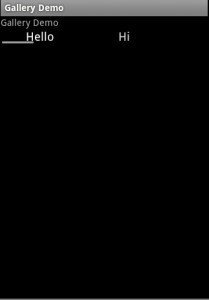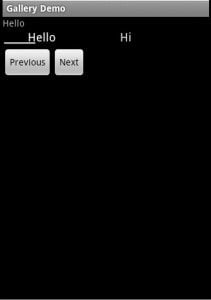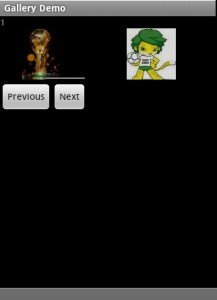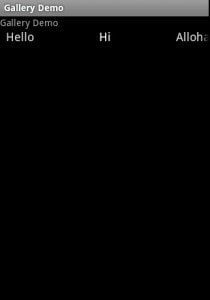Android App Development: Gallery Control
In Android the Gallery control is a selection control that displays items in a horizontal gallery. the items in the gallery appear beside each other. they can appear separated by a pre-defined space.
we can use the gallery to display String items using a simple ArrayAdapter.
so let’s see how to create a gallery that displays the word “Hello” in several languages:
the layout:
<?xml version="1.0" encoding="utf-8"?>
<LinearLayout xmlns:android="https://schemas.android.com/apk/res/android"
android:orientation="vertical"
android:layout_width="fill_parent"
android:layout_height="fill_parent"
>
<TextView
android:layout_width="fill_parent"
android:layout_height="wrap_content"
android:text="Gallery Demo"
/>
<Gallery
android:id="@+id/gallery"
android:layout_width="fill_parent"
android:layout_height="wrap_content"
android:gravity="center_horizontal"
android:spacing="100px"
/>
</LinearLayout>
and in the OnCreate method
@Override
public void onCreate(Bundle savedInstanceState) {
super.onCreate(savedInstanceState);
setContentView(R.layout.main);
gallery=(Gallery)findViewById(R.id.gallery);
//String array holding the values
String [] text=new String[]{"Hello","Hi","Alloha",
"Bonjour","Hallo","¡Hola"};
//Array adapter to display our values in the gallery control
ArrayAdapter arr=new ArrayAdapter(this,
android.R.layout.simple_gallery_item, text);
gallery.setAdapter(arr);
}
the gallery will be like this:
we can increse the spacing between the items by increasing the value of android:spacing property.
we can display a scroll bar to indicate the position of the current selected item in the gallery like this:
<Gallery
android:id="@+id/gallery"
android:layout_width="fill_parent"
android:layout_height="wrap_content"
android:gravity="center_horizontal"
android:spacing="100px"
android:scrollbars="horizontal"
android:scrollbarFadeDuration="0"
android:scrollX="100px"
/>

setting the android:scrollbarFadeDuration=”0″ makes the scroll bar always visible.
The android:scrollX property defines the initial scroll offset of the scroll bar which is the initial distance that the gallery is scrolled for.
Handling Gallery Events:
since the gallery is a selction Control (a adapter view) so it can register a OnItemSelectedListener to handle the selection of items within the gallery.
final String [] text=new String[]{"Hello","Hi",
"Alloha","Bonjour","Hallo","¡Hola"};
gallery.setOnItemSelectedListener(new OnItemSelectedListener() {
@Override
public void onItemSelected(AdapterView parent, View view,
int position, long id) {
// TODO Auto-generated method stub
TextView txt=(TextView)findViewById(R.id.txt);
txt.setText(text[position].toString());
}
@Override
public void onNothingSelected(AdapterView parent) {
// TODO Auto-generated method stub
}
});
now the final step is to add two navigation buttons: Next and Previous to navigate throught the items in the gallery.
the layout is gonna be like this:
<?xml version="1.0" encoding="utf-8"?>
<LinearLayout xmlns:android="https://schemas.android.com/apk/res/android"
android:orientation="vertical"
android:layout_width="fill_parent"
android:layout_height="fill_parent"
>
<TextView
android:layout_width="fill_parent"
android:layout_height="wrap_content"
android:text="Gallery Demo"
android:id="@+id/txt"
/>
<Gallery
android:id="@+id/gallery"
android:layout_width="fill_parent"
android:layout_height="wrap_content"
android:gravity="center_horizontal"
android:spacing="100px"
android:scrollbars="horizontal"
android:scrollbarFadeDuration="0"
android:scrollX="100px"
/>
<LinearLayout
android:layout_width="fill_parent"
android:layout_height="wrap_content"
android:orientation="horizontal"
android:layout_marginTop="5px"
>
<Button
android:text="Previous"
android:layout_width="wrap_content"
android:layout_height="wrap_content"
android:id="@+id/btnPrev"
android:onClick="onClick"
/>
<Button
android:text="Next"
android:layout_width="wrap_content"
android:layout_height="wrap_content"
android:id="@+id/btnNext"
android:onClick="onClick"
/>
</LinearLayout>
</LinearLayout>

now in order to keep track of the index of the currently selected item we need to define two variables
//Variable to store the number of items in the gallery int ItemsInGallery=0; int CurrentIndex=0;
and the navigation buttons click handlers:
@Override
public void onClick(View v) {
// TODO Auto-generated method stub
switch(v.getId())
{
case R.id.btnNext:
//Increase the index
CurrentIndex++;
//if reached the end of the gallery, then start from the first item
if(CurrentIndex>ItemsInGallery-1)
CurrentIndex=0;
gallery.setSelection(CurrentIndex,true);
txt.setText(String.valueOf(CurrentIndex));
break;
case R.id.btnPrev:
//Decrease the index
CurrentIndex=CurrentIndex-1;
//If reached the first item, then return to the last item in the gallery
if(CurrentIndex<0)
CurrentIndex=ItemsInGallery-1;
gallery.setSelection(CurrentIndex,true);
txt.setText(String.valueOf(CurrentIndex));
break;
}
}
Displaying Images:
The Gallery control is populated by an adapter, so we will create a custom adapter that contains ImageViews to display the images.
our custom adapter must inherit from BaseAdapter class
package mina.android.GalleryDemo;
import java.util.ArrayList;
import java.util.List;
import android.content.Context;
import android.view.View;
import android.view.ViewGroup;
import android.widget.BaseAdapter;
import android.widget.ImageView;
public class ImageAdapter extends BaseAdapter {
Context Con;
//array to hold the values of image resources
int [] Resources;
List views;
public ImageAdapter(Context con,int[] resources)
{
Con=con;
Resources=resources;
views=new ArrayList(resources.length);
}
@Override
public int getCount() {
// TODO Auto-generated method stub
return Resources.length;
}
@Override
public Object getItem(int position) {
// TODO Auto-generated method stub
return views.get(position);
//return position;
}
@Override
public long getItemId(int position) {
// TODO Auto-generated method stub
//return views.get(position).getId();
return position;
}
@Override
public View getView(int position, View convertView, ViewGroup parent) {
// TODO Auto-generated method stub
ImageView img=new ImageView(Con);
img.setImageResource(Resources[position]);
views.add(img);
return img;
}
}
then in our activity onCreate Method:
int []res=new int[]{R.drawable.wc,
R.drawable.wc2,R.drawable.wc3,R.drawable.wc4,R.drawable.wc5};
ItemsInGallery=res.length;
ImageAdapter imgAdapter=new ImageAdapter(this, res);
gallery.setAdapter(imgAdapter);
and it will look like this:

and that was the Gallery Control, stay tuned next week for another tutorial






 android
android 